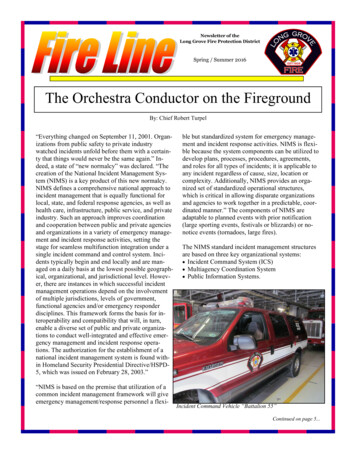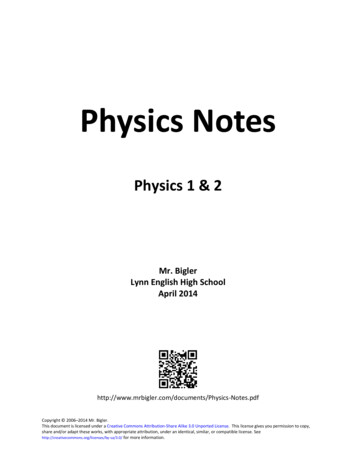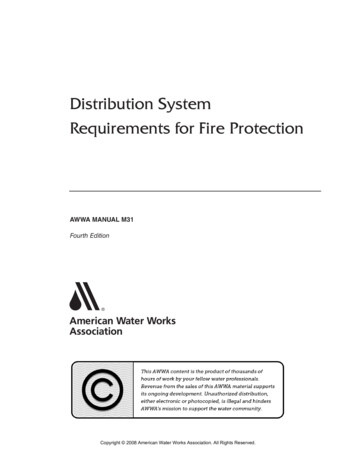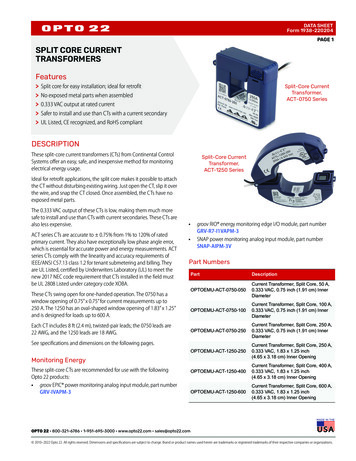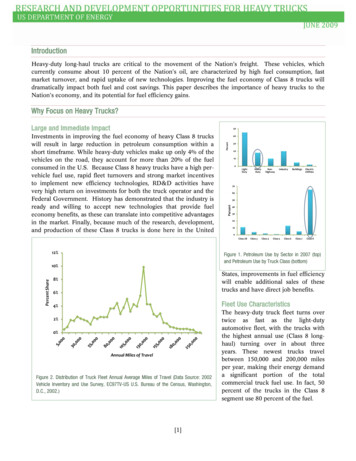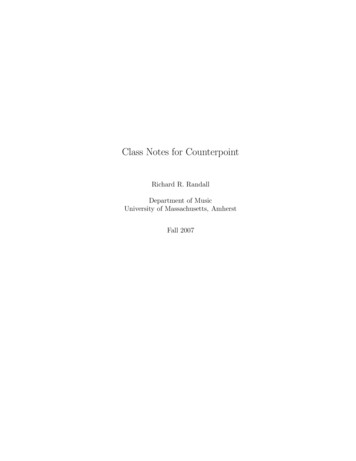
Transcription
Class Notes for CounterpointRichard R. RandallDepartment of MusicUniversity of Massachusetts, AmherstFall 2007
iPreface and AcknowledgmentsThis book is designed to provide you with a solid foundation in counterpoint. Ourdepartment’s belief is that counterpoint is something that should be part of our everyday music making. It is a way to hear music. It is way to understand music. UMassis unique among music programs in that we teach counterpoint in the first semesterof a five semester core curriculum. At other schools, the subject, if taught at all, isoften relegated to an elective. I would like to acknowledge the influence of HeinrichSchenker’s Kontrapunkt(1910) and Felix Salzer and Carl Schachter’s Counterpoint inComposition(1969) in preparing these materials. In addition, I would like to thankmy counterpoint teacher, Miguel Roig-Francoli.Most importantly, I owe a great deal of thanks to my teaching colleagues JessicaEmbry, Adam Kolek, Michael Vitalino, Daniel Huey, and Sara Chung for their hardwork, insightful suggestions, and generous help in preparing this text.
iiIntroductionWhat is Counterpoint?Lat.: contrapunctus, from contra punctum:“against note.”(Fr. contrepoint; Ger. Kontrapunkt; It. contrappunto)Counterpoint is a broad term for interacting yet independent voices. Since theearliest forms of polyphony, musical textures have been made up of multiple “lines” ofmusic (or “voices”) that combine to form vertical sonorities. Studying counterpointteaches us how to recognize and understand those lines. Counterpoint is the essence ofwhat we call “voice leading.” The vertical aspect of music is described as “harmonic.”The horizontal aspect of music is described as “melodic,” or “linear” when talkingabout individual lines and “contrapuntal” when talking about how those melodiesinteract with each other.Counterpoint is not a style or a genre. It’s not even a compositional technique.It’s a principle that is the foundation of much of the music we listen to and perform.The next time you are in chorus, orchestra, wind ensemble, or any other multiplayergroup, try listening to a different part while performing your own. The interplay ofyour part with your neighbor’s is counterpoint.We will study counterpoint using the “species” approach. This approach comprisesfive species1 or levels. This approach was codified by Johann Joseph Fux in his Gradusad Parnassum 2 , first published in 1725. Fux did not in any way “invent” counterpointor its teaching. Nevertheless, his species approach was pedagogically groundbreaking1You may remember from biology that “species” is the most specific level in the classification ofliving things. It’s interesting to think about all of the counterpoint species as being different, yet stillmembers of the same family or genus.2The title translates to Steps to Parnassus. Parnassus was the home of the Greek god Muses andbecame known as the home of poetry, music, and learning.
iiifor its conciseness. It became basic training for many musicians, including giantssuch as Beethoven, Mozart, Mendelssohn, and Brahms. The principal point of thespecies approach is to learn how to control dissonance. The first species allows nodissonance. The second permits metrically unaccented dissonance in the form ofpassing tones. The third presents dissonance as passing tones and neighbor notes.The fourth teaches us how to control metrically accented dissonance in the form ofsuspensions. The fifth species is often called “free counterpoint” and can broadlybe described as a combination of the preceding four species. We focus on speciesone through four partly because of time constraints, but also because fifth speciesborders on (or embraces) 16th century stylistic composition, which is not particularlybeneficial to your education at this point.Why Study Counterpoint?“All musical technique is derived from two basic ingredients: voice leadingand the progression of scale degrees.” —Heinrich SchenkerThe primary reason for studying counterpoint is to train and to develop your earsand mind, so that you can aurally engage in fundamental musical actions and developyour musical intuition about these actions. Have you ever heard a piece of music andhad the feeling that you “knew where it was going to go?” This is musical expectationor intuition.One thing you will learn in this course is that notational symbols really hide morethan they make explicit. What do notes on a page tell us? Essentially they tell uswhen and where to put our fingers and when to press, pluck, bow, or blow. Theydefine physical actions. This is not music—neither are the sounds your instrumentmakes. (If your cat walks on the piano, is that music?) Sounds become music whenwe interpret them, infer relations between them, or simply understand that they areworking together to form something greater than themselves.Many of you may understand what I am talking about, but you don’t have a way toverbally describe these experiences—something you will need to do quite often in theprofessional world. One of the most important features of music theory is that it allowsus to talk to each other. It is a common language with which we can discuss somevery important features of the music that surrounds us in our daily lives. Moreover,music theory provides a way to get beyond the notes by describing the relationshipsthat literally make music. Must we always experience music “theoretically?” No.Of course not. There is a time and place for everything. However, music theory has
ivbeen around as long as music itself and, for better or for worse, it has played anindispensable role in its development and evolution—the two are inseparable.The theory of counterpoint is not a theory of composition. While you will frequently compose examples during the course of our study, it behooves you to keepthis important distinction in mind. This is not to say, however, that your composedexamples ought not to be musical. They should be. The more attention you pay toachieving musicality in your examples, the greater and more rapid your developmentas a sensitive, thinking musician will be.The study of counterpoint follows a logical path. We restrict ourselves to exercisesthat focus on one or two musical problems at a time. Once solutions are masteredand internalized, we introduce new problems in a cumulative fashion. The final resultis a complex musical texture in which you understand why every note is where it isand where every note is going. It is not enough to know the notes and chords; weneed to go farther and learn to understand the relations between them.We do not exist in isolation. Over the span of a thousand years, Western composershave learned to control the simultaneous and successive combinations of musical tones.Our subject of study here at UMass embodies topics and issues that have engagedmusicians, performers, teachers, and composers for millennia.A General ConsiderationThe study of counterpoint (and of music theory in general) is cumulative. This meansthat what we learn in week two still applies in week ten. Moreover, you likely won’tbe able to do the work in week ten unless you have a solid command of the materialfrom week two. Because of this, descriptions of techniques and concepts are moredetailed at the beginning of the text and become shorter and more to the point asthe text progresses. For example, in the first week of study we will spend a good dealof time learning how to write good melodies. Later in the semester, writing goodmelodies is not the goal, but is rather the first step in a larger project. It will beassumed that you can write a good melody and therefore it won’t be explained again.You can always refresh your memory by looking back at an earlier part of the text.Remember:Your understanding of material tomorrow depends on your understandingof material today.
vContentsPreface and AcknowledgmentsiIntroductionii1 The Cantus Firmus11.1Discussion . . . . . . . . . . . . . . . . . . . . . . . . . . . . . . . . . .41.1.1Melodic Consonance and Dissonance . . . . . . . . . . . . . . .41.1.2Contour and the Climax . . . . . . . . . . . . . . . . . . . . . .41.1.3Steps Versus Leaps . . . . . . . . . . . . . . . . . . . . . . . . .52 First Species in Two and Three Voices62.1Contrapuntal Motion . . . . . . . . . . . . . . . . . . . . . . . . . . . .82.2Two Voices . . . . . . . . . . . . . . . . . . . . . . . . . . . . . . . . .92.3Steps for Writing a Good Counterpoint . . . . . . . . . . . . . . . . .112.4Three Voices . . . . . . . . . . . . . . . . . . . . . . . . . . . . . . . .122.4.1The Cadence in Three Voices . . . . . . . . . . . . . . . . . . .142.4.2Special Considerations for Three-Voice CTP . . . . . . . . . . .143 Second Species in Two and Three Voices3.1Two Voices . . . . . . . . . . . . . . . . . . . . . . . . . . . . . . . . .1616
vi3.1.13.2Guidelines . . . . . . . . . . . . . . . . . . . . . . . . . . . . . .18Three Voices . . . . . . . . . . . . . . . . . . . . . . . . . . . . . . . .194 Third Species in Two Voices204.1Two Voices . . . . . . . . . . . . . . . . . . . . . . . . . . . . . . . . .204.2The Double Neighbor . . . . . . . . . . . . . . . . . . . . . . . . . . .235 Fourth Species in Two and Three Voices245.1Two Voices . . . . . . . . . . . . . . . . . . . . . . . . . . . . . . . . .265.2Three Voices . . . . . . . . . . . . . . . . . . . . . . . . . . . . . . . .26
1Chapter 1The Cantus FirmusLat.: “fixed melody.”(Ger. fester Gesang; It. canto fermo.)The term cantus firmus is Latin for fixed melody or song. Its plural is cantusfirmi. The term is most often associated with medieval and Renaissance music andrepresents a pre-existing melody used as the basis of a new composition, but it is alsoassociated with the teaching of counterpoint. Traditionally, the origin of cantus firmiis plainchant (sometimes called “Gregorian” chant). Composers of the Renaissancewould take a cantus firmus and write one or more complementary melodies (counterpoints) against it. It is this idea of each note of one voice part (i.e. a “point”)against (i.e. “counter”) another voice part that gives rise to what we think of as“counterpoint.” We will begin our studies by learning to write cantus firmi. Since ithas its origins in plainchant, a cantus firmus is vocal and not instrumental in nature.This doesn’t mean that you can’t play it on your instrument. It means that when youwrite a cantus firmus, you must write it idiomatically for the voice. (I can play lotsof things on the guitar that I can’t sing, but everything I can sing I can play easilyon the guitar.) In fact, being able to easily sing your cantus firmi (and later, yourcounterpoints) is a good way to check your work.Composers have long used the voice as a guideline because it is the most basic,natural, and universal instrument. We still use it as a metaphor when we discussinstrumental music. For example, we can talk about the “soprano” line in a Beethovenpiano sonata or the “singing” quality of the clarinet in Brahms’s famous quintet.Recall that counterpoint is the study of voice leading. Voice leading is the waytwo or more independent melodic lines interact. When two or more voices are singing
2simultaneously, we call that a polyphonic texture. Composers didn’t start writing polyphonic music until around 1100 CE. Before that time, composers concernedthemselves with writing only single lines, principally for voice. Over the centuries,the cantus firmus has become an integral part of the teaching of counterpoint. Itis the first step a student takes towards understanding what is often called “freecomposition.”All of the rules in this chapter are intended to insure two things: first, that acantus firmus is singable, and second, that your cantus firmus fulfills a basic standardof “musicality.” While the concept of the former should be familiar to you, theconcept of the second might not be. What is “musical” is a cultural and historicalidea. What is “musical” in India may not be considered musical in the Bronx orin China. In addition, what is musical to a jazzer might not be considered musicalto a strictly legit (the old-school term for “classical”) musician, or vice versa. Inthe United States we primarily subscribe to the musical principles of the WesternEuropean music tradition. The reason I say this is to help you overcome the instinctto dismiss rules and guidelines because they don’t conform to your idea of what musicis. It’s not that your idea of “music” isn’t valid, it’s just that it is only one of aninfinite number of possible “musics.”Learning to compose and recognize good cantus firmi is essential because theircharacteristics are present in all good melodic lines. We begin with the basic rules.Please keep in mind that the goal right now is to write melodies that are correctaccording to these rules—not to write the best melody that ever was. For example,while Essential Elements may not be as exciting as Sibelius’s Violin Concerto, it’s animportant first step in learning to be a great musician. Keep your melodies as simpleas possible. Simple is good.Figure 1.1: A good cantus firmus written by JeppesenFigure 1.1 shows a model cantus firmus. Notice that the range is within a perfect fifth. It is singable in a single breath. There are no radical melodic gestures.Everything is simple and relaxed. It’s beautiful and controlled without force. It hasa distinctive but not distracting contour. It has a single zenith climax and smoothgentle motion to the cadence. Sing this example and play it a few times. Memorizeit. Try to internalize how little effort it takes to think about it and sing it. All ofyour cantus firmi (and later counterpoints) should have these qualities.
3Here are the rules for writing a good cantus firmus:1. Written in alto clef.2. Begin and end on tonic (1̂).3. Must end with the melodic progression 2̂ 1̂.4. Completely diatonic. No chromaticism.5. Must have variety. No single note (or group of notes) should be overly emphasized.6. Do not repeat notes.7. Do not outline dissonant melodic intervals.8. Mostly, but not entirely, by step.9. Range no more than a tenth.10. Leaps(a) Don’t overuse.(b) No dissonant melodic intervals.(c) Should be preceded or followed by a motion in opposite direction. Following a leap by step in opposite direction is often good.(d) If larger than a perfect fifth, then only the octave and the ascending minorsixth are permissible.(e) Octave and minor sixth leaps must be preceded and followed by a motionin the opposite direction.(f) Two successive leaps are permissible but only ifi. Preceded and followed by a motion in the opposite direction.ii. They split an octave with a perfect fifth on the bottom and a perfectfourth on top.iii. They form the pattern third/fourth or third/third (measuring fromlow to high.)11. Must have a single and unique climax, either a zenith or anadir.
41.11.1.1DiscussionMelodic Consonance and DissonanceUnderstanding, appreciating, and learning to control dissonance is an important partof studying counterpoint. However, there is difference between harmonic dissonancesand melodic dissonance. For example, the harmonic interval of a second is verydissonant, but the melodic interval of a second is consonant.Melodic dissonances are: Any augmented interval or diminished interval. Major or minor sevenths. Anything larger than an octave. (This is really just for us.)Melodic consonances are: Major and minor seconds. Major and minor thirds and sixths. Perfect fourths, fifths, and octaves.1.1.2Contour and the ClimaxContour describes the “up/down” or “high/low” pattern of a melody in pitch space.A good melody will have a distinctive and varied contour. This ensures that thelistener remains interested and engaged. A good cantus firmus has a unique highpoint or a unique low point called a climax.A climax is a point of rhetorical forcefulness (e.g. “the climax of his speech.”),the point of highest dramatic tension (e.g. “the climax of the movie.”), or simplythe culmination of a series of events. In melody writing, climaxes are divided intotwo types: a zenith (a high climax) or a nadir (a low climax). When you write yourmelodies, you might want to try to write from the beginning to the climax, then fromthe climax to the cadence.
5Figure 1.2: Dos and Don’ts for double leaps.1.1.3Steps Versus LeapsThe treatment of leaps is one of the most important considerations when writing amelody. We will be very strict about what you can and cannot do. While we’ve listedthe rules above, we’ll take the time to go over them again. Never write a dissonantmelodic interval (a diminished fifth or an augmented fourth, or a major or minorseventh). A single octave leap or an ascending minor sixth is OK, but not a majorsixth. Leaps of a minor sixth and octave must be both preceded and followed bychange of direction. Occasionally two successive leaps in same direction are allowed,only when (1) both are preceded and followed by changes of direction, (2) the twointervals span a perfect octave in the pattern 5/4, but never 4/5 (measuring from lowto high), and (3) 3/4 (never 4/3) good and also 3/3 so long as qualities follow thepattern of minor/major or major/minor, never major/major or minor/minor. SeeFigure 1.2 for some examples.
6Chapter 2First Species in Two and ThreeVoicesThe combination of two or more voice parts to form a single musical gesture is oneof the hallmarks of art music in the Western tradition. There is a kind of paradox inpolyphony. The voices should be as independent as possible, but their combination,the way they interact, must be strictly controlled. In a way, they are both independentof each other and dependent on each other. We learned how to write a cantus firmusin Chapter 1. In our ensuing exercises, a cantus firmus will be provided (see theAppendix) and your job now is to write a counterpoint against it. You will composeyour counterpoint melodies following most of the same rules you learned for cantusfirmus writing. There will be a single climax, motion mostly by step, leaps must betreated properly, etc. The difference will be in the beginning and ending.At the beginning, counterpoints (abbreviated CTPs) can start on 1̂ or 5̂ whenabove the cantus firmus (abbreviated CF). Counterpoints must begin on 1̂ whenbelow the CF. Permissible beginnings are shown in Figure 2.1.Counterpoints (CTPs) end with the scale degree progression 7̂ 1̂, complementingthe cantus firmus’s 2̂ 1̂. This cadential combination is so important that it has itsown name: the clausula vera and its variants are shown in Figure 2.2. The clausulavera (CV) is Latin for “true closure” and is the ultimate goal for a piece. Look atthe end of almost any Renaissance, Baroque, Classical, or Romantic piece of music,and you will find a CV.
7Figure 2.1: Permissible opening intervals for two-voice counterpoints.Figure 2.2: Three permissible clausula vera.
8Figure 2.3: The four different types of contrapuntal motion.2.1Contrapuntal MotionThere are four ways that voices can move against each other (see Figure 2.3):1. Parallel. Both voices move in the same direction by the same melodic interval.2. Similar. Both voices move in the same direction by different melodic intervals.3. Oblique. One voice moves against another voice which does not move.4. Contrary. Voices move in opposite directions, either away or towards eachother.These four motions are presented in order of increasing independence. Parallelmotion gives the least sense of melodic independence. Contrary motion gives thegreatest sense of melodic independence. Perfect intervals are very strongly related toeach other. Remember that these intervals are formed by the first three partials inthe overtone series. In fact, two notes that are a perfect fifth or an octave apart blendtogether so well that they can easily be mistaken for a single note. Special care mustbe given to these intervals because they can rob voices of their independence. Justthink about how independent two melodies would be if played in unison or at theoctave! That said, a good counterpoint will have a variety of these types of motion.In first species in two voices, we will not use oblique motion often, if at all.
92.2Two VoicesIn first species, there is a one to one relation between the CF and the CTP. In otherwords, for every one note of the CF, there is a CTP note of equal value. In allcounterpoint exercises, we are very concerned about the quality of intervals createdbetween the voices—the harmonic intervals. In first species in two voices we can onlyhave harmonic consonances between voices and special care must be given to perfectfifths, octaves, and unisons. The basic rules for first species in two voice are as follows:1. Written with no meter with one CTP note for every CF note.2. When written above CF, CTP is in treble clef. When written below CF, CTPis in bass clef.3. Use only consonant harmonic intervals: perfect fifths (P5), perfect unisons andoctaves (PU and P8), major and minor thirds (M3 and m3), and major andminor sixths (M6 and m6).14. The P4 is a dissonance in two voices.5. The PU is used only to begin or end a phrase in first species, never within thephrase.6. Perfect intervals approached only by contrary motion never parallel or similarmotion.7. Only exceptions are “horn fifths” or “horn octaves,” defined similar motion 3-5,or 5-8 when the top voice moves by step.8. Never write consecutive P8s or consecutive P5s (either parallel or antiparallel).9. No overlapping of voices.10. No voice crossing.11. No more than three parallel thirds or parallel sixths in succession.12. Strictly diatonic (except for leading tones in minor modes, mixolydian, and5̂ !6̂ !7̂ 1̂ in minor). Add altered notes only at cadence, not mid-phrase.1We will abbreviate interval names. Perfect intervals will be written “P” with the numerical size;minor intervals are indicated with a lower case “m”, major intervals with an upper case “M” withthe numerical size; augmented and diminished intervals are indicated by “A” and “D” respectively.Often we will be discussing intervals in a general kind of way and therefore refer to them just bynumbers.
10Figure 2.4: Overlap: the G of the CF goes higher than the E of the CTP.Figure 2.5: Voice crossing: the A and B of the CTP are above the F and G of theCF.You are required to label all harmonic intervals in every counterpointexercise. Examples of overlap and voice crossing are given in Figures 2.4 and 2.5. Acomplete first species counterpoint is given in Figure 2.6. Play through it. Try playingone part while singing the other. Once you can do that, swap parts. In Figure 2.6the climaxes and CV are labeled. Notice that while the climaxes occur at the sametime, they are of different types.For composing in two voices in general (all species), observe the following guidelines:I. Write CF in alto clef and CTP in treble clef if above CF or in bass clef if below.It is much easier to adhere to spacing rules this way.II. Label all intervals with generic numbers, either between or directly below thetwo voices.III. Equally good independent voices in opposition.
11Figure 2.6: First species counterpoint in two voices.IV. Climaxes must be at different times or of different types.V. Begin with a PU, P5, or P8.VI. If counterpoint (CTP) is above the cantus firmus (CF), then CF begins on 1̂and CTP begins on 1̂ or 5̂.VII. If CTP is below CF, then CTP begins on 1̂ (and so does CF).VIII. End on a PU or a P8 as part of clausula vera (CV).IX. Don’t exceed a tenth between voices. Don’t extend beyond octave too often.(When absolutely necessary, it’s OK to transpose the CF up or down an octavein order to conform to this range limitation.)2.3Steps for Writing a Good CounterpointHere are five steps that will help you succeed at writing counterpoint. We presentthem here in the first species chapter (and they apply mainly to two-voice writing),but you should refer to them for every species and make the necessary adjustmentsas you go. Never write a counterpoint with the idea that you’re going towrite it correctly the first time. Sketch out ideas. Write in pencil. Cross thingsout. Move things around. Make corrections. If one solution isn’t working out, thentoss it in the trash and start again. This is the normal way to work. You will be alot less frustrated if you understand and accept this process.1. Look over and sing through the cantus firmus. Identify its climax, mode, andrange.
122. Choose a starting pitch for your counterpoint. It must be either an octave,unison, or fifth if above the first note of the cantus firmus, or an octave orunison if below (never a fifth below). Choose a note that will allow you to movein contrary motion with the cantus firmus without the voices crossing.3. Compose the counterpoint. It should have mostly stepwise motion, punctuatedby a few leaps, a single climax or nadir at a point other than the same point asthe CF, and a smooth, arching, singable contour. It also should have a range ofan octave or at most a tenth from the cantus firmus at any simultaneity, andcover an overall range of no more than a tenth. Motion between the CF andCPT should be mostly contrary. Write the harmonic intervals betweenthe CF and CPT as you go.4. The last two notes of the CTP must be 7̂ 1̂ of the mode, forming a CV withthe CF. The vertical intervals of the last two sonorities must be either 6—8 ifending on an octave, or 3—1 if ending on a unison. If there is a whole stepbetween 7̂ and 1̂ in the mode you are in, raise the leading tone.5. Check your solution.(a) Sing the CTP line. Sing it while you play the CF on an instrument.(b) Be sure that there are no parallel fifths or octaves, no melodic or harmonictritones (diminished fifths or augmented fourths), no more than three parallel thirds in a row, that all fifths and octaves are approached by contrarymotion, that the voices do not cross, that there is never more than a tenthbetween the CF and CPT, that the range of the CPT is no more than atenth, and that all leaps are correctly treated.(c) Recheck all written intervals.(d) Copy your assignment over if it is not neatly written.2.4Three VoicesWe can add a second counterpoint to create a three-voice texture. Rather thancalling our two composed voices CTP1 and CTP2, we will call this third voice theaccompaniment (ACC), creating the triumvirate: CF, CTP, and ACC. Since you canonly put the CV, creating 7̂ 1̂ in one voice we will call that voice the CTP. TheACC does not participate in the CV, but is still present at the scene.The three-voice texture creates a distinction between the outer voices (fulfillingbass and soprano roles) and the inner voice. In the Renaissance, the three voices would
13Figure 2.7: First species counterpoint in three voices.be equal in weight with no one voice being more important than any other. Beginningin the Baroque, the inner voice took on a supporting, or filling, role. A hierarchy wascreated such that the outer voices were considered more important than the innervoices. It is undeniable that the outer voices are more audible than a combinationinvolving the inner voice. Nevertheless, except for some special treatment of the bass,we will strive to treat the three voices as equal as possible.Intervalically, we now have two areas of concern: the interval formed between theupper two voices, and the intervals formed between the lowest voice (the bass) andeach of the upper two voices. You will always label the intervals between theupper two voices between or directly below them. You will always labelthe bass-inner, bass-soprano intervals below the bass, aligned vertically(like this: 63 or 85 ). You must label your intervals. We are most interested in theintervals that involve the bass and the upper two voices. It is conventional to placelarger numbers above smaller numbers when notating intervals. You should do thisas well.1. No more than an octave between two upper voices (except for one or two notes).2. No more than a twelfth between two lower voices.3. Voices may cross, but not below the bass.Sonorities1.or 63 are best. (A diminished fifth between upper two voices is acceptable, butnever with bass.)532. Avoid85and3. Never use 64 .88within the phrase.
144. Penultimate sonority must be one of the sonorities in item 1. It must be composed of three different pitch classes.You will notice as you write in your intervals that the 63 sonority produces a perfectfourth, and in some cases an augmented fourth (!), between the upper two voices—which you were told was forbidden in two-voice writing. The fourth is perfectlyacceptable in three-voice writing so long as it does not involve the bass. This is theexception to the “all voices are equal” statement I made above. All the voices arekind of equal, with the bass actually being the most important. Just remember, whenyou’re writing your intervals below the staff, you should never see a “4.”2.4.1The Cadence in Three VoicesCadences in three-voice textures require special attention. While it’s obvious that weneed a CV, it’s not entirely obvious what to do with the ACC voice. In a cadence, theACC really does support the other two voices. Below are the guidelines for three-voicecadences. Pay careful attention to these rules because they are relevant for all speciesin three voices, not just first species. You will notice that below I have written !3̂.This is because, regardless of the mode (major or minor), if there is a third formedwith the bass’s 1̂ in the final sonority, then it will always be a major third. This iscalled a Picardy third and its usage dates back to the 16th century and continues(with great irregularity) even today. We will use Picardy thirds as a kind of “tip ofthe hat” to an old tradition. Conditions for cadences in three voices are:1. Must contain a CV between the CF and CTP.2. If7̂ 1̂2̂ 1̂are in upper voices, then lower voices moves 5̂ 1̂.3.
This book is designed to provide you with a solid foundation in counterpoint. Our . music theory provides a way to get beyond the notes by describing the relationships . piano sonata or the “sin




